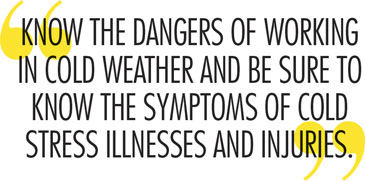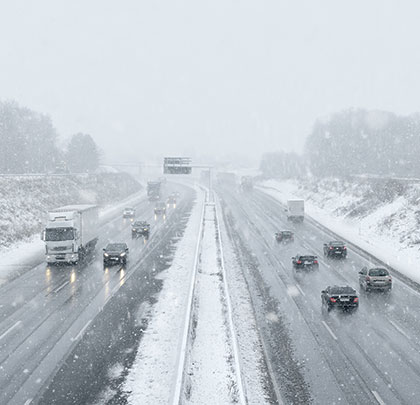The Weather Channel showcased the blizzard that struck North Dakota in early December. Near-zero visibility, drifted snow blocking roads, and snow plows fueled and ready to hit the streets—welcome to winter.
For construction companies rushing to finish outdoor projects while the snow is still manageable, workers need to pay close attention to the dropping temperatures. Working in cold weather brings health risks. Knowing the dangers and symptoms are critical to keeping safe on the jobsite.
KNOW THE RISKS
The colder it gets outside, the more energy you burn to keep warm. And, if the weather conditions are windy, rainy, or snowing, your body uses even more energy and loses heat faster. Long-term working in cold weather can lead to health problems.
Hypothermia: This is a condition when your body temperature drops to 95 degrees F or lower. You may begin to shiver and stomp your feet to stay warm. Other symptoms include feeling unusually tired, loss of coordination, sense of becoming confused, and you may even lose consciousness.
Frostbite: This occurs when your skin freezes and becomes red with gray/white patches. The skin in that area feels numb; you can’t feel the area. In serious cases, frostbite causes the skin to blister and even lead to amputation.
Trench Foot: This happens when your feet have prolonged exposure to wet and cold conditions. Tissue becomes tingly/itchy, red and blotchy, and swollen and/or numb. You simply can’t feel your feet. Wet feet lose heat faster and circulation begins to shutdown, resulting in skin tissue beginning to die.
Chilblains: This condition is caused by repeated exposure of skin to temperatures just above freezing to as high as 60 degrees F. The cold exposure causes damage to the groups of small blood vessels in the skin. The damage is permanent and the redness and itching returns with additional exposure.
Seek medical attention or alert a coworker to get help if any of these conditions present while on the jobsite.

PROTECT YOURSELF
Besides common sense, there are OSHA recommendations for protecting yourself in cold weather. The following are three steps to working safely in cold weather.
1. DRESS FOR THE WEATHER
OSHA recommends wearing the following:
- Inner and outer layers that will keep you dry; clothing should be loose, not tight
- A hat or hood that covers your ears, and a knit mask (if needed)
- Waterproof and insulated gloves
- Waterproof and insulated boots
Carry extra clothes in case the ones you are wearing become wet. Have a thermometer and chemical hot packs in your first aid kits.
2. DRINK THE RIGHT LIQUIDS
To avoid becoming dehydrated, drink plenty of warm, sweet liquids, such as:
- Sports drinks
- Soups
- Sugar water
Avoid liquids with caffeine, such as:
- Coffee
- Tea
- Soda
- Hot chocolate
Do not drink alcohol. Caffeine and alcohol cause your body to lose heat.
BE PROACTIVE AND ALERT
When working in a cold environment or a long period of time:
- Learn the signs and symptoms of cold weather illnesses and injuries
- Take frequent breaks in a warm area
- Work in pairs so you and your coworker can spot the danger signs
- Notify your supervisor and get medical help immediately if you or another worker has symptoms of hypothermia or another cold-related illness or injury
- Remember—you are at a higher risk if you take certain medications, are in poor physical condition, or suffer from illnesses such as diabetes, hypertension, or cardiovascular disease
Staying safe on the jobsite is a top priority no matter the season, but winter adds another level of caution. Stay alert in cold weather conditions and stay safe. ■
About The Author: Article information provided courtesy of The Center for Construction Research and Training (CPWR). To learn more about how to work safely in cold weather, visit the Occupational Safety and Health Administration (OSHA) at www.osha.gov, and visit the National Institute for Occupational Safety and Health (NIOSH) at www.cdc.gov/niosh.
_________________________________________________________________________
Modern Contractor Solutions – December 2016
Did you enjoy this article?
Subscribe to the FREE Digital Edition of Modern Contractor Solutions magazine.



